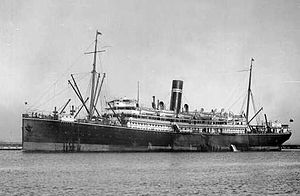TSS Kanowna

An undated photograph of Kanowna
|
|
| History | |
|---|---|
|
|
|
| Name: | Kanowna |
| Operator: | Australian United Steam Navigation Company |
| Route: | Sydney to Fremantle |
| Builder: | William Denny and Brothers, Dumbarton, Scotland |
| Fate: | Ran aground and sank, 19 February 1929 |
| General characteristics | |
| Tonnage: | 6,993 tons |
| Length: | 126 metres (413 ft) |
TSS Kanowna, was an Australian steamer built during 1902. The 6,993-ton, 126-metre (413 ft) long Kanowna was constructed by William Denny and Brothers of Dumbarton, Scotland, and had a twin screw design.
Kanowna was operated by the Australian United Steam Navigation Company (AUSNC), and it served the Sydney to Fremantle route.
During August and September 1914, Kanowna was requisitioned by the Australian military to transport 1,000 soldiers to German New Guinea as part of the Australian Naval and Military Expeditionary Force. Sailing late from Townsville on 8 August, the ship was forced to anchor off Thursday Island until 16 August, and did not arrive off Port Moresby until 6 September. The expeditionary force sailed the next day for Rabaul, but Kanowna fell behind the rest of the convoy, with the ship's master signalling to HMAS Sydney that his crew had mutinied: the boiler stokers and firemen had stopped work. In Arthur Jose's Royal Australian Navy-focused volume of the Official History of Australia in the War of 1914–1918, he claims that the mutiny was because these men refused to leave Australian waters, but Tom Frame and Kevin Baker state in Mutiny! that this is incorrect; the troopship was on short rations of food and water because of the delays sailing north and only minimal resupply in Port Moresby, but the stokers and firemen were requesting more water to remain hydrated in the hot boilerrooms and to wash off coal grime, and refused to work until this demand was met. The workers were taken into the custody of a party of soldiers, and the force's commander ordered Kanowna to return to Townsville, with soldiers volunteering to keep the ship running. The Australian Commonwealth Naval Board conducted an inquiry into the mutiny, even though as a civilian vessel, Kanowna technically wasn't under their jurisdiction. The state of the supplies was seen as a major contributing factor to the sailors' actions.Kanowna was returned to her owners on 21 September.
...
Wikipedia
